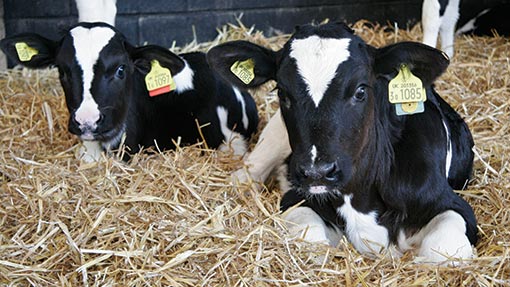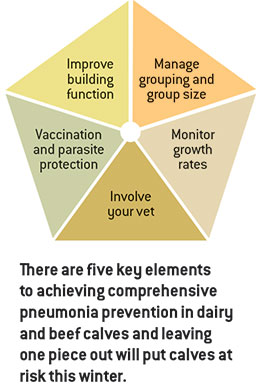New cow shed helps Cumbrian farmer cut pneumonia

Building a new cow shed to accommodate an expanding dairy herd gave one Cumbrian farmer a chance to look at ways to reduce pneumonia risk.
David Martin, who runs a 230-head closed Holstein herd on his 120ha farm near Levens, had suffered from outbreaks of the disease thanks in part to poor ventilation in his old stone shed.
Investing in a new 23,000 building in March 2013 meant he was able to look at all the ways to improve air flow in the unit to help limit the risk of illness.
Vet tips
While computerised calf feeders can bring labour-saving benefits, vet Mark Stott warns they require extra care to ensure pneumonia problems dont arise.
Ideally, all-in, all-out systems where calves are grouped according to age are best, but often thats not possible on farms with automatic feeders, he says.
If you have a trickle in and out of calves all using the same teat, that can cause problems.
It is a calfs worst enemy to enter a group with older calves that are close to weaning, as they havent built up disease protection yet, says Mr Stott.
These systems can make vaccination even more important to ensure calves are properly protected.
As our cow numbers increased, the old stone shed couldnt cope with the number of cows going through the system, says Mr Martin.
I researched everything with the new shed to get the best design I could to avoid pneumonia.
“It has automatic curtaining to raise and lower the temperature and wind speed and a steeper-pitched roof at 22.5deg to help with the air flow. We can also steam clean it.
But despite building improvements, Mr Martin found pneumonia was still causing problems for the herd.
The first lot of calves went through fine, but we were still getting pneumonia and the growth rate in the calves wasnt great, he says. They were a real mixed bag anything from 0.8kg/day and higher to as low as 0.5kg/day.
Blood tests helped identify which viruses the calves had been exposed to, and based on this information, Mr Martin started using an intranasal Pi3v and BRSv vaccine on calves when they were nine days old.
We calve year-round, so we give the vaccine at nine days old regardless of what time of year it is, he says. We do it once and it gives them that initial cover, and then once they are on dry feed, they are OK.
Vet Mark Stott says the vaccine has had a significant effect, as calves were often coming down with the disease before they were old enough to be given an injectable vaccine.
It only lasts for 12 weeks, but we are finding that is enough protection, he says.
 On Mr Martins farm as on many dairy farms we find if we get them over that very early risk period, we dont tend to get problems later.
On Mr Martins farm as on many dairy farms we find if we get them over that very early risk period, we dont tend to get problems later.
The calves are fed colostrum and whole milk until they are vaccinated, at which point they are put on an automatic calf feeder and fed milk powder.
They are also given dry feed ad lib before being weaned at eight weeks old, when they are separated to minimise mixing of age groups.
Mr Martin says the feeding system helps reduce the stress of diets being changed suddenly, which further cuts the risk of respiratory disease and helps achieve more consistent growth.
We havent been able to see the full results of the new system yet, but the calves are growing more consistently. We are now aiming for 0.8kg/day growth and we are hoping to achieve two-year calving.
If the calves dont get that pneumonia setback when they are young, they dont get damage to their lungs that can last a lifetime, he adds.
We have had pneumonia in cows in the past, but hopefully, if they dont get that damage as young animals, it will ensure they are strong enough to fight off illness.
Since vaccinating calves, pneumonia outbreaks on the unit are incredibly rare, meaning antibiotic use has gone down significantly, he says.
The vaccine is an additional cost, but if we avoid pneumonia, get good growth rates and calve the cow a few weeks early, we easily save the cost of vaccine on feed alone.
It also saves a lot in treatment. Antibiotics use has definitely gone down, and you are not constantly jabbing calves. It is a win-win situation for everyone.
Find out more about the main causes of pneumonia in calves, the effect of poor housing and the best way to treat the disease with our online academies. View our Winter Health academy
Sponsor’s message

The last thing dairy farmers need as they start a new days work this winter is to find a dead calf or, worse still, several. Yet without exception, everyone who has ever worked with calves knows the horrible, hollow feeling in the pit of their stomach when this happens.
Unfortunately, this remains a possibility on too many dairy farms this winter, when they can little afford the losses. Fortunately, a number of things that can be done to reduce its probability are covered in this five-part series. It is sponsored by Zoetis, maker of Rispoval4 and Rispoval IntraNasal vaccines.
As a starting point, the potential financial losses due to pneumonia or, more positively, the gains available from effective prevention on your own scale of operation can be calculated quickly with a new online planning tool.
See also:
